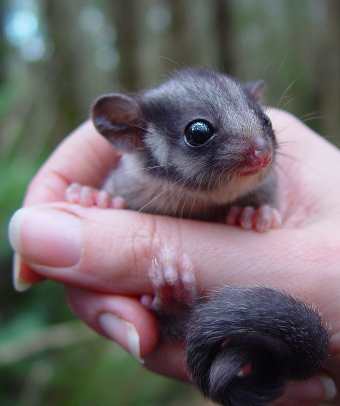Subscription Center



 Scientists and conservationists this week said they will petition the Australian government to change the status of the Leadbeater’s possum from “endangered” to “critically endangered,” a designation shared by only four other Australian mammals. The tiny marsupial (Gymnobelideus leadbeateri) is one of two faunal emblems of Australia’s State of Victoria, but it has suffered badly since 2009. The species lost more than 40 percent of its habitat that year during the infamous Black Sunday bushfires, which swept through the state and killed or injured more than 600 people.
Scientists and conservationists this week said they will petition the Australian government to change the status of the Leadbeater’s possum from “endangered” to “critically endangered,” a designation shared by only four other Australian mammals. The tiny marsupial (Gymnobelideus leadbeateri) is one of two faunal emblems of Australia’s State of Victoria, but it has suffered badly since 2009. The species lost more than 40 percent of its habitat that year during the infamous Black Sunday bushfires, which swept through the state and killed or injured more than 600 people.
The bushfires were another blow for the possums, which were thought to be extinct for 50 years before they were rediscovered in 1961. Even before the fires the animals could only be found in about 150 nonconsecutive square kilometers of habitat. Today fewer than 1,500 of the possums remain, and scientists are warning that numbers could soon drop further if immediate action is not taken.
“The species’s future is really at the crossroads,” Zoos Victoria biologist Dan Harley told The Age. “It is now or never if we are going to save it from extinction.”
Most of the Leadbeater’s possum’s problems stem from one activity: logging of their unique rainforest habitat. The animals live only in mountain ash forests, making their homes hundreds of feet aboveground in the hollows of centuries-old dying and decaying trees. The trees also provide the habitat for the invertebrates the possums rely on for food, such as spiders and beetles, especially during the cold winter months when less plant matter is available. Not only does logging remove these massive trees, it also fragments the habitat—separating population groups from one another—and allows the growth of more easily ignitable plants, making these tropical rainforests more likely to burn again in the future. The possum’s environs have been so degraded by logging that most of the suitable trees are dead and falling down, and the current crop of trees may not be old enough to produce the right nesting conditions for another 50 years or more.
Unfortunately, the logging companies operating in Victoria have 20-year leases. If that policy doesn’t change, the possums may not have a chance. As David Lindenmayer, a professor of ecology at Australian National University, wrote last week in The Conversation, about half of the mountain ash forest in Victoria that is available for logging will be cut down by 2016. Three months ago Lindenmayer resigned from a government task force charged with protecting the possum, citing lack of government action to slow the pace of logging. “There’s been absolutely no change to the amount of logging that is going on in those forests,” he told The Age this past September. “Locking in 20-year contracts for the forests in Victoria will lock in the extinction of Leadbeater’s possum, and I can’t be involved in a recovery team that has no effect on environmentally bankrupt policy.”
Lindenmayer is calling for a 50 to 75 percent reduction in Victoria logging, the establishment of a national park to protect mountain ash trees—the planet’s tallest flowering plants—and creating “retention islands” where pristine lands preserve habitat for the possums and other species.
Meanwhile Harley is working to protect the possums in a different manner: Zoos Victoria has established a very small captive breeding program, and this past May received a two-year-old male that will serve as the “male founder” for the program. Selecting the breeding program’s participants wasn’t easy—Leadbeater’s possums mate for life. Harley told The Sydney Morning Herald the zoo needed to pick possums that were both unattached and healthy. The zoo’s Healesville Sanctuary hopes to add two more breeding pairs each year for the next three years, with an ultimate goal of establishing a captive assurance population of 150 animals.
Photo: Dan Harley via Flickr. Used under Creative Commons license
Add a Comment
You must sign in or register as a ScientificAmerican.com member to submit a comment.
Click one of the buttons below to register using an existing Social Account.